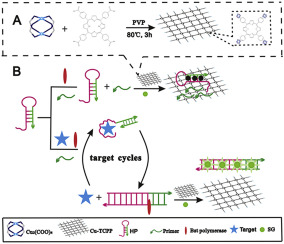当前位置:
X-MOL 学术
›
Anal. Chim. Acta
›
论文详情
Our official English website, www.x-mol.net, welcomes your feedback! (Note: you will need to create a separate account there.)
A two dimensional metal–organic framework nanosheets-based fluorescence resonance energy transfer aptasensor with circular strand-replacement DNA polymerization target-triggered amplification strategy for homogenous detection of antibiotics
Analytica Chimica Acta ( IF 6.2 ) Pub Date : 2018-08-01 , DOI: 10.1016/j.aca.2018.02.058 Qian Yang , Lingying Zhou , Yong-Xiang Wu , Kai Zhang , Yuting Cao , You Zhou , Dazhen Wu , Futao Hu , Ning Gan
Analytica Chimica Acta ( IF 6.2 ) Pub Date : 2018-08-01 , DOI: 10.1016/j.aca.2018.02.058 Qian Yang , Lingying Zhou , Yong-Xiang Wu , Kai Zhang , Yuting Cao , You Zhou , Dazhen Wu , Futao Hu , Ning Gan

|
In the study, a novel two dimensional metal-organic framework (Cu-TCPP nanosheets) based fluorescence resonance energy transfer (FRET) aptasensing platform was developed for detecting antibiotics. Cu-TCPP nanosheets were employed for quenching the background fluorescence and circular strand-replacement DNA polymerization (CSRP) for signal amplification. To fulfill the purpose, we designed an aptamer hairpin probe (HP) whose stem can be opened while specifically binding to target. Then the opened HP would bind with the primer. Under the action of polymerase, extension reaction was induced to generate double-stranded DNA (dsDNA), and then the target was released for the next cycle. Finally, SYBR Green I (SG) can bind with dsDNA to produce strong fluorescence response for quantification of target. It's worth mentioning that the fluorescence of HP/SG complex and free SG could be completely quenched by Cu-TCPP nanosheets while that of dsDNA/SG complex wouldn't be affected. Thus, the sensor produced negligible background signals. It can produce 7.5-fold improved S/N compared to a graphene oxide (GO)-based FRET aptasensor. Chloramphenicol (CAP) was chosen as the model analyte to demonstrate the feasibility of the sensor system. The detection range is broad from 0.001 to 10 ng mL-1 with a detection limit down to 0.3 pg mL-1. The proposed assay was label free and can be used in homogenous detection which greatly simplifies the complexity of operations. The strategy opens a new way to develop sensitive, in-situ and simple assay for antibiotics in foods.
中文翻译:

基于二维金属-有机骨架纳米片的荧光共振能量转移适体传感器,具有环状链置换DNA聚合靶触发扩增策略,用于抗生素的均相检测
在这项研究中,开发了一种新型的基于二维金属有机骨架(Cu-TCPP 纳米片)的荧光共振能量转移(FRET)适配传感平台,用于检测抗生素。Cu-TCPP 纳米片用于淬灭背景荧光和环状链置换 DNA 聚合 (CSRP) 用于信号放大。为了实现这一目的,我们设计了一种适体发夹探针 (HP),其茎可以打开,同时与目标特异性结合。然后打开的 HP 将与引物结合。在聚合酶的作用下,诱导延伸反应生成双链DNA(dsDNA),然后释放靶标进入下一个循环。最后,SYBR Green I (SG) 可以与 dsDNA 结合产生强烈的荧光响应,用于目标的定量。它' 值得一提的是,HP/SG 复合物和游离 SG 的荧光可以被 Cu-TCPP 纳米片完全淬灭,而 dsDNA/SG 复合物的荧光不会受到影响。因此,传感器产生的背景信号可以忽略不计。与基于氧化石墨烯 (GO) 的 FRET 适体传感器相比,它可以产生 7.5 倍改进的 S/N。选择氯霉素 (CAP) 作为模型分析物以证明传感器系统的可行性。检测范围从 0.001 到 10 ng mL-1,检测限低至 0.3 pg mL-1。所提出的测定是无标记的,可用于均相检测,大大简化了操作的复杂性。该策略为开发灵敏、原位和简单的食品中抗生素检测开辟了一条新途径。
更新日期:2018-08-01
中文翻译:

基于二维金属-有机骨架纳米片的荧光共振能量转移适体传感器,具有环状链置换DNA聚合靶触发扩增策略,用于抗生素的均相检测
在这项研究中,开发了一种新型的基于二维金属有机骨架(Cu-TCPP 纳米片)的荧光共振能量转移(FRET)适配传感平台,用于检测抗生素。Cu-TCPP 纳米片用于淬灭背景荧光和环状链置换 DNA 聚合 (CSRP) 用于信号放大。为了实现这一目的,我们设计了一种适体发夹探针 (HP),其茎可以打开,同时与目标特异性结合。然后打开的 HP 将与引物结合。在聚合酶的作用下,诱导延伸反应生成双链DNA(dsDNA),然后释放靶标进入下一个循环。最后,SYBR Green I (SG) 可以与 dsDNA 结合产生强烈的荧光响应,用于目标的定量。它' 值得一提的是,HP/SG 复合物和游离 SG 的荧光可以被 Cu-TCPP 纳米片完全淬灭,而 dsDNA/SG 复合物的荧光不会受到影响。因此,传感器产生的背景信号可以忽略不计。与基于氧化石墨烯 (GO) 的 FRET 适体传感器相比,它可以产生 7.5 倍改进的 S/N。选择氯霉素 (CAP) 作为模型分析物以证明传感器系统的可行性。检测范围从 0.001 到 10 ng mL-1,检测限低至 0.3 pg mL-1。所提出的测定是无标记的,可用于均相检测,大大简化了操作的复杂性。该策略为开发灵敏、原位和简单的食品中抗生素检测开辟了一条新途径。


























 京公网安备 11010802027423号
京公网安备 11010802027423号